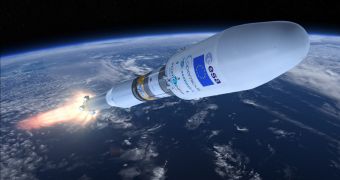Officials with the European Space Agency (ESA) are proud to announce that the very first Copernicus satellite has made its way to the Kourou Spaceport in French Guiana, South America. This satellite has been in the works for years, and it should pick up studying Earth from where other missions left off.
The Sentinel-1 mission consists of two separate spacecraft, each of them carrying a single C-band Synthetic Aperture Radar (SAR) instrument. The purpose of this small constellation is to provide data continuity for the former Envisat and European remote sensing satellite (ERS) missions.
These two programs collected a massive amount of data on our planet while they were in operation. Envisat was originally scheduled to observe our planet for just 5 years, but the spacecraft managed to achieve 10 years in orbit, before being declared lost on May 9, 2012.
The first spacecraft in the Sentinel-1 combo arrived at Kourou on February 24, coming by plane all the way from Europe. Dubbed Sentinel-1A, the satellite is currently scheduled to launch on April 3 from the Ensemble de Lancement Soyouz (ELS) pad at the spaceport.
It will be ferried into space aboard a Russian-built Soyuz medium-lift delivery system and inserted into a Sun-synchronous, dawn-dusk orbit, at an altitude of around 693 kilometers (430 miles). Sentinel-1A will complete an orbital cycle once every 96 minutes. Mission duration is expected to exceed 7 years.
The advanced SAR instrument aboard the satellite is capable of conducting Earth observations regardless of weather. It can pierce through rain and cloud covers, and it can image the ground equally well at day and at night. SAR technology is derived from side-looking airborne radars (SLAR).
Despite arriving at Kourou in extremely poor weather, spaceport workers and engineers from manufacturer and top ESA contractor Thales Alenia Space unloaded the spacecraft on Monday, supported by the crew of the Antonov aircraft that delivered it from the Old Continent.
“It was great to see our baby arrive safely and everyone worked efficiently to carefully unload the precious cargo. We now look forward to unpacking the satellite and getting it ready for its journey into space in a few weeks’ time,” said the manager of ESA's launch campaign, Svein Lokas.
Once in orbit, Sentinel-1A will not only provide amazing views of the Earth in radar bands, but it will also map land subsidence and polar ocean ice drifts, as well as provide a handy tool for first responders in case of a calamity.
Unlike other satellites, this mission was developed in a way that allows for it to be quickly repurposed for observing flooding or earthquakes and assist with saving any potential victims. When Sentinel-1B is launched, this capability will be further extended.

 14 DAY TRIAL //
14 DAY TRIAL //